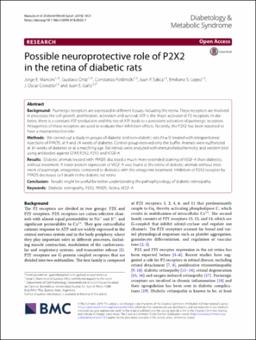| dc.description.abstract | Abstract
Background: Purinergic receptors are expressed in diferent tissues including the retina. These receptors are involved
in processes like cell growth, proliferation, activation and survival. ATP is the major activator of P2 receptors. In diabetes, there is a constant ATP production and this rise of ATP leads to a persistent activation of purinergic receptors.
Antagonists of these receptors are used to evaluate their inhibition efects. Recently, the P2X2 has been reported to
have a neuroprotective role.
Methods: We carried out a study in groups of diabetic and non-diabetic rats (N=5) treated with intraperitoneal
injections of PPADS, at 9 and 24 weeks of diabetes. Control group received only the bufer. Animals were euthanized
at 34 weeks of diabetes or at a matching age. Rat retinas were analyzed with immunohistochemistry and western blot
using antibodies against GFAP, P2X2, P2Y2 and VEGF-A.
Results: Diabetic animals treated with PPADS disclosed a much more extended staining of VEGF-A than diabetics
without treatment. A lower protein expression of VEGF-A was found at the retina of diabetic animals without treatment of purinergic antagonists compared to diabetics with the antagonist treatment. Inhibition of P2X2 receptor by
PPADS decreases cell death in the diabetic rat retina.
Conclusion: Results might be useful for better understanding the pathophysiology of diabetic retinopathy. | en_US |


